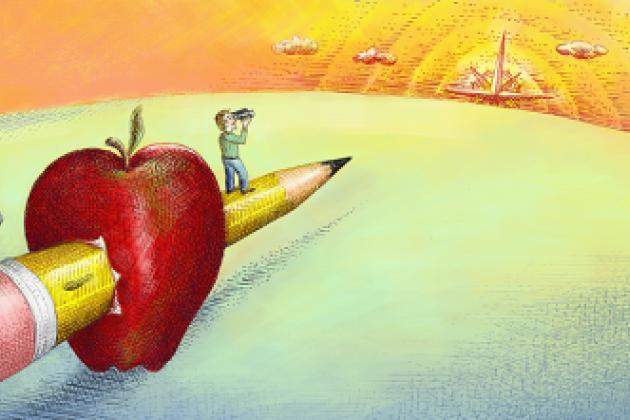- Education
Editor's note: This essay is an excerpt from the new book Failing Our Brightest Kids: The Global Challenge of Educating High-Ability Students (Harvard Education Press).
Why pay special attention to high-ability girls and boys? Won’t they do fine anyway? Shouldn’t we concentrate on kids with problems? Low achievers? Poor kids?
Good questions all, particularly when American education leaders (and their counterparts in most other advanced countries) are preoccupied with equalizing opportunity, closing gaps, and giving a boost to those most challenged—and when resources are chronically scarce. Yet such questions have two compelling answers.
First, the country needs these children to be highly educated in order to ensure its long-term competitiveness, security, and innovation. Frederick Hess is correct: these are the young people who hold perhaps the greatest promise for making major advances in science, technology, medicine, the humanities, and much more. The same point was framed in different words in the 1993 federal report “National Excellence: A Case for Developing America’s Talent”: “In order to make economic strides,” the authors wrote, “America must rely upon many of its top-performing students to provide leadership—in mathematics, science, writing, politics, dance, art, business, history, health, and other human pursuits.”
This isn’t just rhetoric. Economists don’t agree on much, but almost all concur that a nation’s economic vitality and growth depend heavily on the quality and productivity of its human capital and its capacity for innovation. At the forefront of creation, invention, and discovery are—nearly always—the society’s cleverest, ablest, and best-educated men and women. Yes, other personal and national characteristics also loom large (such as hard work, enterprise, natural resources, stable laws, reliable banks, peace in the streets), but nothing trumps the knowledge and imagination of a country’s people. Whether we are picturing breakthroughs in information technology, alternative forms of energy, more efficient engines, vaccines against Ebola, ultrapowerful telescopes, or environmentally sound crop enhancers for wheat fields, we depend on smart, creative, and highly educated individuals to lead the way.
The U.S. economy is already hobbled by our shortage of such homegrown talent (and further shackled by limits on importing such people from overseas). Organizations like the Partnership for a New American Economy and U.S. Chamber of Commerce estimate that one-fourth of American science and engineering firms now face difficulty hiring the workforce they need—and forecast a shortage of
220,000 workers with STEM (science/technology/engineering/math) degrees by 2018. It’s true that changing our immigration policies would ease the crunch. But what sensible nation would rely on other countries to educate and supply its highly skilled workers?
This challenge extends beyond the tech world. In November 2014, the Wall Street Journal reported that foreign applicants (especially from India and China) are besting American candidates for admission to high-status U.S. business schools because they’re doing far better on the quantitative portion of the Graduate Management Admission Test. Some leading universities are turning to country-specific scoring systems so that American applicants get compared only with fellow Americans—a sort of affirmative action scheme for people educated in our own schools and colleges! “U.S. students’ raw scores on the quantitative section have remained roughly flat over the last decade,” the Journal explained, “but their percentile ranking has fallen as more of their higher-scoring international counterparts take the exam.”
The problem is not that the United States lacks smart children; it’s that such kids aren’t getting the education they need to realize their potential. Other countries are forging ahead, while “roughly flat” accurately describes the American record. Using international test data, economists Eric Hanushek and Ludger Woessmann estimate that a “ten percentage point increase in the share of top-performing students” within a country “is associated with 1.3 percentage points higher annual growth” of that country’s economy (measured in per-capita GDP). Which is to say, if the United States propelled as many of its young people into the ranks of high achievers as, say, the Netherlands, this country would be mark- edly more prosperous—with faster growth, higher employment, better wages, and all that comes with these. (If 1.3 percentage points looks modest, consider that the average annual U.S. growth rate over the past forty years has been just 1.5 percent.)
The second big reason to attend to the schooling of high-ability youngsters is a version of the familiar equity argument: these kids also deserve an education that meets their needs and enhances their futures, just like children with other distinctions and problems. They have their own legitimate claim on our conscience, our sense of fair- ness, our policy priorities, and our education budgets. What’s more, many of them also face such challenges as disability, poverty, ill-educated parents, non-English-speaking homes, and tough neighborhoods.
Those kids depend more than upper-middle-class youngsters on the public education system to do right by them. Some will manage to overcome the constraints of their upbringing, but many will fall by the wayside, destined by circumstances beyond their control never to realize their full potential. As Ford Foundation president Darren Walker recently remarked, “[E]ven though talent is spread evenly across America, opportunity is not.” That’s why our failure to extend such opportunities to more high-ability kids from disadvantaged backgrounds is, as the Jack Kent Cooke Foundation team recently put it, “both unacceptable and incompatible with America’s long-term prosperity.”
That’s also why high-functioning public school systems such as that of Fairfax County, Virginia (FCPS), declare their commitment to widening opportunities for children with talent and “to providing challenging learning experiences for all learners that build on individual strengths and optimize academic potential. In order to meet the needs and develop the potential of advanced learners, FCPS provides a continuum of advanced academic services.”
Yet we have a long way to go before it can be said that “advanced learners” from poor circumstances are achieving anywhere near their more fortunate classmates. Today, a random American fifteen-year-old is four times likelier to be a top scorer on PISA math than is her lower socioeconomic age-mate. A woeful 2 percent of Americans in the lowest SES quartile reached the uppermost PISA ranks in math, reading, or science in 2012. By contrast, in the top SES quartile, 20 percent of U.S. test takers made it to that level in math, as did 18 percent in reading and 17 percent in science.
Plenty more poor kids have the ability, but lots of them lack the supports from home and family that middle-class children enjoy, and many attend schools awash in low achievement, places where all the incentives and pressures on teachers and administrators are to equip weak pupils with basic skills in reading, writing, and arithmetic. Such schools understandably invest their resources in boosting low achievers. They’re also most apt to judge teachers by their success in doing that and least apt to have much to spare—energy or time, incentive or money—for students already above the proficiency bar. These might fairly be termed the kids that NCLB forgot.
We are by no means the first to flag this problem. As the authors of that 1993 report declared: “The United States is squandering one of its most precious resources—the gifts, talents, and high interests of many of its students. . . . This problem is especially severe among economically disadvantaged and minority students, who have access to fewer advanced educational opportunities and whose talents often go unnoticed.” (Emphasis added.)
In the years since, similar alarms have been sounded time and again. In A Nation Deceived, published in 2004, Nicholas Colangelo, Susan G. Assouline, and Miraca Gross meticulously demonstrate how able children benefit from an accelerated education—and the damaging role of misguided education beliefs and practices in holding back such children.
In a 2008 Fordham Institute publication, after analyzing NAEP data over the previous decade, Tom Loveless of the Brookings Institution cautioned: “Gaps are narrowing because the gains of low-achieving students are outstripping those of high achievers by a factor of two or three to one. The nation has a strong interest in developing the talents of its best students to their fullest to foster the kind of growth at the top end of the achievement distribution that has been occur- ring at the bottom end. International comparisons of top stu- dents around the world invariably show American high-achievers falling short.”
In Mind the (Other) Gap, published in 2010, the University of Connecticut’s Jonathan Plucker and colleagues again documented the widening “excellence gap” in American education, as “the economically disadvantaged, English Language Learners, and historically underprivileged minorities” have come to comprise a shrinking “proportion of students scoring at the highest levels of achievement.”
Two years later, in Unlocking Emergent Talent, Paula Olszewski-Kubilius and Jane Clarenbach of the National Association for Gifted Children wrote that, “While our nation continues to express commitment to closing the achievement gap, the proportion of low-income students performing at advanced levels on the National Assessment of Educational Progress remains shamefully low. For example, between 1998 and 2007, 2% or fewer of free and reduced lunch program-eligible students scored at the advanced level on the eighth-grade math exam compared to between 6% and 10 % of non-eligible students.”
Caroline Hoxby and Christopher Avery made waves in 2013 with evidence that even low-income youngsters who do exceptionally well in high school, earning excellent grades and lofty SAT or ACT scores, are far less likely than their affluent peers to wind up in high-status colleges, despite ample evidence that they could gain admission, obtain sufficient financial aid, and succeed academically. Why? Because they tend not even to apply to such colleges; nobody at home or school encourages them to do so and explains how to go about it. Nor do university “outreach” efforts manage to find many of them. Hoxby and Avery estimate that tens of thousands of high achievers from disadvantaged backgrounds are thus “missed” by the elite strata of American higher education—and these are youngsters who have succeeded in K–12 education despite all the obstacles.
Plucker and colleagues returned to the “excellence gap” in October 2013 with a penetrating summary of research attesting to the K–12 system’s failure to cultivate the talents of high-ability kids from disadvantaged circumstances—and bluntly stated that policy efforts to close the “minimum competency gap,” important as they are (“an ethical and moral priority”), are not narrowing the excellence gap, “a unique problem that will not be solved without concerted effort.”
Most recently, March 2015 brought a valuable study from the Jack Kent Cooke Foundation, entitled Equal Talents, Unequal Opportunities, which used multiple metrics to appraise how well individual states are advancing the education of high-ability, low-income youngsters. The report’s bleak conclusion: “No state received full points in either policy inputs or student outcomes, which left us unable to give any state an ‘A’ grade.” (In fact, just six states earned student-outcome grades in the “B” range—and there were scads of D’s.)
One may rightly term this amply-documented situation shameful, but one ought not find it surprising. Consider the children’s differing circumstances.
It’s true that not all upper-middle-class kids with strong ability can count on having education-maximizing parents—some are content for their children to be well-adjusted and popular—and some youngsters themselves lack motivation. Yet the odds are hugely better that such girls and boys will get an education that does a decent job of capitalizing on their potential, beginning in their earliest months on earth. For they are all but certain to have adults in their lives who read to them, ask them questions that don’t have simple answers, show them intriguing things, and take them to interesting places—adults with the knowledge and capacity to navigate our complicated education system in pursuit of suitable options for their daughters and sons, and to press for access to the best of those options. These are adults who possess resources that enable them to shift to better options when necessary, whether that means changing neighbor- hoods, purchasing supplemental education offerings, even sending their children to private schools.
Equally able youngsters from poor families, on the other hand, depend mainly on their local public education system to supply them with suitable learning opportunities. Many start school behind the eight ball because they haven’t learned as many words or been asked to think about as many complicated things or seen as many informative places as their more-advantaged classmates. Many also enter schools that have a weak record of academic achievement and are staffed by less experienced teachers.
All of this puts at further risk those youngsters who were disadvantaged to begin with, compared with their middle-class peers, and makes it less likely that they will receive an education that nurtures their ability to the max. Able as they may be, they face a double whammy because their schools are beset by more urgent problems: poor attendance, children arriving hungry or sick, discipline challenges, language issues, and more. Such schools may also be strapped for resources—money, expert instructors, materials, and so on. Maximizing the potential of their high-ability, high-achieving pupils may be something that principals and teachers yearn to do but are simply too swamped to devote the energy and resources it requires.
Whether the children in a particular school are poor or rich, virtually all of the public-policy pressures, incentives, and accountability schemes of recent decades—whether arising from local, state, or federal sources, from private philanthropy, or from the priorities and values of educators themselves—have pushed teachers and administrators to concentrate on low achievers, those who, in the language of No Child Left Behind, are not yet “proficient” or “making adequate yearly progress” in reading or math.
Helping students climb over the proficiency bar wins points and plaudits for the school, but boosting them further up the achievement ladder rarely does. Schools and teachers earn few incentives or rewards for causing such youngsters to learn more. Meanwhile, plenty of these students’ peers are termed “at risk”—in terms of not just prior achievement but also disabilities, immigrant status, home language, and other factors—and government (and philanthropic) funding streams, mandates, accountability systems, and special programs focus on schools’ success in mitigating or compensating for such risks.
This is certainly true in the United States in the NCLB era, as that sweeping 2001 federal law focused entirely on low-achieving students. Moreover, it was recently reframed by education secretary Arne Duncan to prod states and districts to concentrate their energies and resources on the very worst schools—Duncan emphasizes the lowest-performing 5 percent—not those attended by the children with greatest potential to become academic superstars. While poorly per- forming schools harbor some of those kids, too, government policy effectively marginalizes them as among the (few) pupils the school does not have to worry about. Their low-achieving classmates get the attention. Instead of concentrating our policy energies on both boost- ing the entire distribution of performance and targeting extra help on those farthest behind, we have for years been devoted almost exclu- sively to the latter.
Government policy is not, however, the only driver of this focus on low achievers and troubled schools. Education discourse in the United States, as well as the preoccupations of most foundations, think tanks, pundits, and colleges of education, seems to have forgotten or repressed the grand tension that John Gardner highlighted a half-century back. Can we, in fact, “be equal and excellent too? ” Despite another claxon sounded two decades later by the National Commission on Excellence in Education, the quest for excellence has all but vanished from our education priorities—and it’s more thoroughly absent when such questing means paying attention to the schooling of high-ability children.
A senior faculty member at one of the country’s top schools of education commented to us that the very phrase “gifted education” is a “tainted construction” among leading thinkers, policy influencers, and institutions in the field. He added that none of his faculty col- leagues focus on such issues—they’re much more interested in ending poverty, compensating for disability, fostering cultural pluralism, and boosting low achievement—and that his school’s placement office wouldn’t think of sending graduates anywhere but into the most troubled and disadvantaged settings.
Such comments match our own impressions as we ride the circuit of conferences, workshops, policy seminars, and legislative initiatives around the public education field. As a simple reality check, however, we searched for “gifted education” on the websites of the ten graduate schools of education rated most highly by U.S. News. That well turned out to be almost dry. We found two or three interested (if somewhat ambivalent) professors, one full-fledged graduate degree program, a couple of optional “endorsements” for special ed certification, several one-day seminars, and a summer program for kids and teachers, but little else.
Why this neglect? Briefly stated, America’s failure to solve these problems arises from a mix of ideology, political correctness, flawed education theories, and disagreements over who qualifies as “gifted.” Even when we agree on which children meet that definition, we divide over what to do with them. Should they be taught within “inclusive” classrooms or separately? Do they, in fact, deserve anything different at all? Some say that programs focused on such children are elitist and contend that “these kids will do fine anyway, so let’s concentrate on those who are having difficulty.” Others wonder what will happen to late bloomers. Still others discount talent and ability altogether, insisting that personal qualities such as “grit” are the key to high achievement. In today’s culture, creating special opportunities for high-ability, high-achieving youngsters also invites allegations of discrimination.
Many educators object to separating students in any way. They decry all forms of “tracking” and “grouping” as archaic and unfair. And they’re not entirely wrong, considering how yesterday’s tracking schemes often had a deterministic, immutable aspect that tended to permanently separate student populations and limit educational and social mobility. Any successful (and politically acceptable) approach to education in the United States in the twenty-first century must instead recognize this as a “land of opportunity” and education as a source of second chances. But that doesn’t mean ignoring youngsters of exceptional ability or achievement—or assuming that everyone in fifth grade is equally adept at learning math or history, much less that they’re all at the same level of achievement today.
















